文体学分析作业
国高考一轮复习第5分实用类文本阅读第一单元第三节分析文体特征和表现手法试题
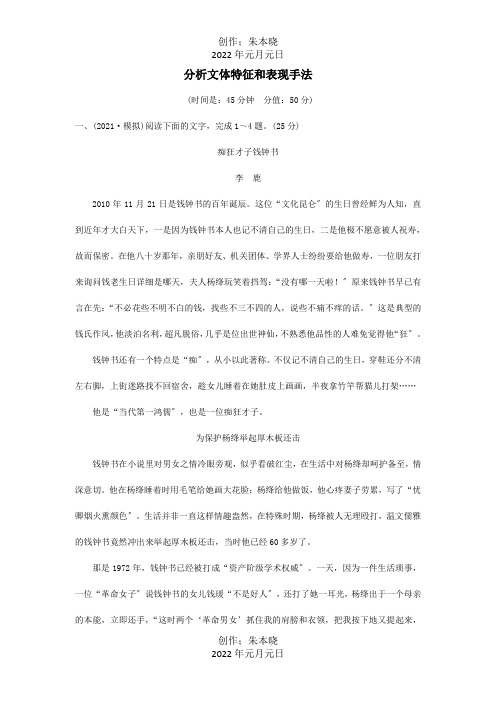
分析文体特征和表现手法(时间是:45分钟分值:50分)一、(2021·模拟)阅读下面的文字,完成1~4题。
(25分)痴狂才子钱钟书李鹿2010年11月21日是钱钟书的百年诞辰。
这位“文化昆仑〞的生日曾经鲜为人知,直到近年才大白天下,一是因为钱钟书本人也记不清自己的生日,二是他极不愿意被人祝寿,故而保密。
在他八十岁那年,亲朋好友、机关团体、学界人士纷纷要给他做寿,一位朋友打来询问钱老生日详细是哪天,夫人杨绛玩笑着挡驾:“没有哪一天啦!〞原来钱钟书早已有言在先:“不必花些不明不白的钱,找些不三不四的人,说些不痛不痒的话。
〞这是典型的钱氏作风,他淡泊名利,超凡脱俗,几乎是位出世神仙,不熟悉他品性的人难免觉得他“狂〞。
钱钟书还有一个特点是“痴〞,从小以此著称。
不仅记不清自己的生日,穿鞋还分不清左右脚,上街迷路找不回宿舍,趁女儿睡着在她肚皮上画画,半夜拿竹竿帮猫儿打架……他是“当代第一鸿儒〞,也是一位痴狂才子。
为保护杨绛举起厚木板还击钱钟书在小说里对男女之情冷眼旁观,似乎看破红尘,在生活中对杨绛却呵护备至,情深意切。
他在杨绛睡着时用毛笔给她画大花脸;杨绛给他做饭,他心疼妻子劳累,写了“忧卿烟火熏颜色〞。
生活并非一直这样情趣盎然,在特殊时期,杨绛被人无理殴打,温文儒雅的钱钟书竟然冲出来举起厚木板还击,当时他已经60多岁了。
那是1972年,钱钟书已经被打成“资产阶级学术权威〞。
一天,因为一件生活琐事,一位“革命女子〞说钱钟书的女儿钱瑗“不是好人〞,还打了她一耳光,杨绛出于一个母亲的本能,立即还手,“这时两个‘革命男女’抓住我的肩膀和衣领,把我按下地又提起来,又摔下,又提起,又摔下〞,杨绛回忆,她当时一声都没叫喊,钱钟书本来在房间里看书,该是听到撕扯中木架倒地的声音跑了出来。
看见妻子被打,“他举起木架子侧面的木板(相当厚的木板),对‘革命男子’劈头就打。
幸亏对方及时举臂招架,板子只落在胳臂肘上,如打中要害,后果就不堪设想了〞。
英语文体学案例分析

relationships Functional tenor: the news is on China Daily, an
official news paper, the focus is on accuracy and objectivity.
Semantic Features
1. objectivity:. (1) Using objective facts to show people the new method of the matter(2)A positive attitude is conveyed through the careful choice of words.
2. Meaning contraction: The information is arranged from general to specific and the meaning is expressed directly with easy transition to the readers to achieve clarity
"The parents of the missing children authorized us to post their information on our products in July. So far we have produced 500,000 bottles, most of which are being sold in local supermarkets, airports and train stations. The first batch of water bottles ... will remain on the market for a year, while the information of more missing children will be printed on our products in the future," a manager surnamed Wang told Dz, a local news portal.
对比文体学作业纸(1)-语音层文体特征分析-11翻译w-学号-王雪组

对比文体学作业纸(1):语音层文体特征对比分析也具有意义连觉的作用,体现了悲伤地情感。
My aspens dear, whose airy cages quelled,Quelled or quenched in leaves the leaping sun.All felled, felled, are all felled:[G. M. Hopkins. Binsey Poplars] 我亲爱的白杨树,在通风的笼子里,平息或淬火般的叶子,在跳跃的阳光下。
所有砍伐,砍伐,全部砍伐反韵反韵出现在quelled与quenched,leaves与leaping之间,从而形成音节上的语音平行结构模式,同时加强了quelled与quenched之间的关系,使得读者联想到阳光被遮住的意象。
Thou mastering meGod! giver of breath and bread;World’s strand, sway of the sea,Lord of living and dead;Thou hast bound bones and veins in me,Fastened me flesh.And after it almost unmade, what with dread.Thy doing: and dost thou touch me afresh? Over again I feel thy finger and find thee.[G. M. Hopkins. The Wreck of the Deutschland] 你掌控着我,上帝!给予我生命和面包;世界的链,摇摆的海,是活着和死亡的造物主,你融进我的血肉中,即使毁灭又有什么恐惧呢?试着这样做:触摸我好吗?再一次,我就会感到你的存在,并找到你们。
押韵此行中每行行尾押韵音节都是重读单音节,从而使诗句铿锵有力,与诗歌所表达的上帝居高临下、主宰一切的主题相一致。
高三难点突破100题难点22分析文本的文体基本特征和主要表现手法含解析 试题

难点22 分析文本的文体根本特征和主要表现手法不同的文体,其使用的主要表现手法是不一样的。
有的以记叙为主,有的侧重描写,有的有宏大的场景,有的注重感情的表达,有的关注细节的描写等。
实用类文本的类型主要有传记、新闻、报告、科普文章等。
考生在平时的复习中,要注意积累相关的文体知识,只有对文体知识有了全面的理解,才能准确把握文体特征,解题时才能沉着不迫。
传记:1.兼具真实性和文学性。
其中,真实性是传记的第一特征,但传记不同于一般的枯燥的历史记录,它具有文学性。
它是写人的,有人的生命情感在里面。
2.阅读传记时,要注意理清作品陈述的根本领实,分析传主的性格、情感,理解作者的观点态度,把握作者的写作意图。
新闻:1.用事实说话,迅速及时地反映社会现实问题。
2.阅读新闻时,要注意看清标题,揣摩新闻类型;抓住各个要素,理解主要内容;理清行文线索,分析段落层次;明确中心意思,理解文本大意;辨明表现手法,以供分析综合。
报告:1.材料真实,针对性强。
2.阅读报告时,要注意文本运用的典型材料,使用的比照材料和有关数据。
同时,要注意分析概括文本所包含的观点,并能结合实际作出自己的判断。
科普文章:1.科学性和兴趣性相结合。
2.阅读科普文章时,要注意分析文本所呈现的科学现象,包含的科学道理及其现实意义。
另外,在分析文本的表现手法时,考生还要注意联络已有知识,比方各种抒情方式、论证方法、修辞手法等。
阅读下面的文字,完成后面的题目。
二等兵——吉布森回家了【美】约翰·费特曼星期三深夜,诺克特县城欣迪曼镇上大多数人已进入梦乡。
陆HY二等兵吉布森〔外号“小鸭子〞〕的遗体从越南运回家来了。
时值夏天,天气闷热,但当载着灰色HY棺的灰色灵车开进镇子的时候,下起了暴雨。
豆大的雨点落在铮亮的灵车上熠熠闪光,街上一片雾气。
黑暗中的欣迪曼显得非常静穆。
日前,二等兵吉布森的遗体经奥克兰空运至辛辛那提,由陆HY上士里特护送回家。
在欣迪曼镇,当HY棺从车上抬出时,殡仪馆的一位工作人员对他的同事小声说:“这就是小鸭子,他们把他带回来了。
文体学分析作业
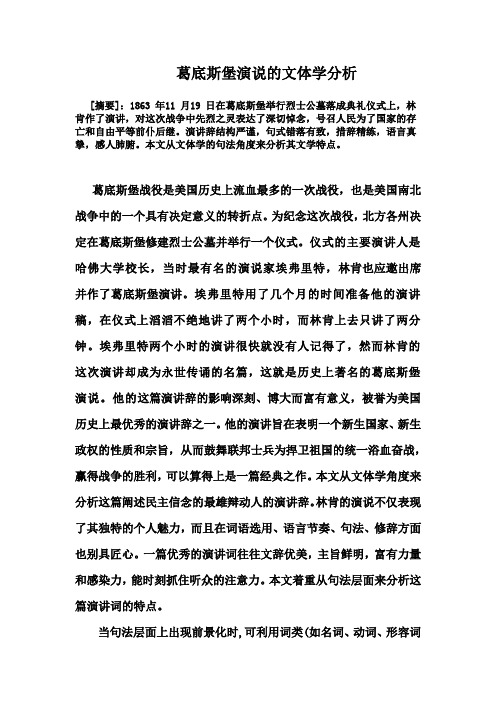
葛底斯堡演说的文体学分析[摘要]:1863 年11 月19 日在葛底斯堡举行烈士公墓落成典礼仪式上,林肯作了演讲,对这次战争中先烈之灵表达了深切悼念,号召人民为了国家的存亡和自由平等前仆后继。
演讲辞结构严谨,句式错落有致,措辞精练,语言真挚,感人肺腑。
本文从文体学的句法角度来分析其文学特点。
葛底斯堡战役是美国历史上流血最多的一次战役,也是美国南北战争中的一个具有决定意义的转折点。
为纪念这次战役,北方各州决定在葛底斯堡修建烈士公墓并举行一个仪式。
仪式的主要演讲人是哈佛大学校长,当时最有名的演说家埃弗里特,林肯也应邀出席并作了葛底斯堡演讲。
埃弗里特用了几个月的时间准备他的演讲稿,在仪式上滔滔不绝地讲了两个小时,而林肯上去只讲了两分钟。
埃弗里特两个小时的演讲很快就没有人记得了,然而林肯的这次演讲却成为永世传诵的名篇,这就是历史上著名的葛底斯堡演说。
他的这篇演讲辞的影响深刻、博大而富有意义,被誉为美国历史上最优秀的演讲辞之一。
他的演讲旨在表明一个新生国家、新生政权的性质和宗旨,从而鼓舞联邦士兵为捍卫祖国的统一浴血奋战,赢得战争的胜利,可以算得上是一篇经典之作。
本文从文体学角度来分析这篇阐述民主信念的最雄辩动人的演讲辞。
林肯的演说不仅表现了其独特的个人魅力,而且在词语选用、语言节奏、句法、修辞方面也别具匠心。
一篇优秀的演讲词往往文辞优美,主旨鲜明,富有力量和感染力,能时刻抓住听众的注意力。
本文着重从句法层面来分析这篇演讲词的特点。
当句法层面上出现前景化时,可利用词类(如名词、动词、形容词等)知识分析非常规的或标记性的词序或句法组合。
由于公众演讲的空间限制和形式决定它较之日常谈话更正式和严明的特点,又由于公众演讲对象水平多层次限制和演讲引起听众共鸣的目的和要求,它没有法律问题或科技问题那么正式,演讲的文体介于口语和书面语之间,因此公众演讲在句法结构方面也有了更多的鲜明特色。
①句子结构。
演讲问题的句子长度比日常谈话、即席演说或商业广告等文体都有明显的增加。
文体学分析文章
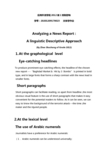
应用外语学院2012级1班赵舒畅学号:20201209170023 文体学作业Analyzing a News Report :A linguistic Descriptive Approach(By Zhao Shuchang of Grade 2012)1.A t the graphological levelEye-catching headlinesTo produce prominent eye-catching effects, the headline of the chosen new report ---“Baghdad Market Is Hit by 3 Bombs” is printed in bold type, and in large fonts that forms a sharp contrast with the news lead in smaller fonts.Short paragraphsShort paragraphs can facilitate reading, so apart from headline ,the most obvious visual feature is the use of short paragraphs that makes it easy convenient for the potential readers to follow. As it can be seen, we can easy to know the background of the terrorist attack---the time ,the maker and the injured people.2.At the lexical levelThe use of Arabic numeralsJournalists have a preference for Arabic numerals:(1.Arabic numerals can be understood universally;(2.Arabica numerals take less time and space to be printed than English equivalents;(3.Arabica numerals can make things more reasonable.Therefore, this news use a lot of Arabica numerals, for example, 51 people, more than 9o,200people, 22miles, wounding 15 and so on.The use of names of placeTo make the news appear precise and concrete, lots of names of places are given prominence, for instance:Fadhil, Diyala, Sadr City, Khalis,Iskandariyah,Duluiyah,Anbar and so on.3.At the syntactical levelSentence types and complexityIn the sample news report, these news are statements suitable for the dominant function of giving information .Besides ,the journalists usually alternate between the use of long and short, complex and simple sentences to make the reading easier and give variety to the rhythm of the article and to break the boredom of reading.Frequent use of quotations phrasesFor the same reason as that of the sentence complexity in the news report , quotations phrases are frequently used to make it convinced and save the space. Instance are listed as follows:“The offensive also led to the seizure of several car bombs that were ready to donate as well as weapons and posters that encouraged sectarian violence ,Iraqi army officials said.”“Wounds sustained due to enemy action, the military said Saturday.”4. At the semantic levelAnalysis of the features of journalistic English at this level mainly focuses on the realization and interpretation of the meaning of the sample news report.The headlineHeadlines play a vital role in drawing readers’ attention to the news story. In the sample news report, the editor designs on headline.In the straight headline“Baghdad Market Is Hit By 3 Bombs’, seven simple powerful words are used to convey a “where, what”. Also, the subheading’ use tell me the” when, what , who “in detail .The leadThe opening paragraph of the news report is the lead---the gist of the whole message, which is an important character of news reporting. In the simple sentence ,we can get answers to the key questions:What: triple car bombing struckWhere: a busy shopping districtWhen : SaturdayHow: killing at least 51people and wounding more than 90 in an attack timed to inflict as many casualties as possible.5. Text presentationThe sample report of the news event goes in a logical order: The most important thing comes first, then follow the detailed information in a logical order:(1.summarize the event(2.Describe the event in detail6. SummaryIn this article, I have analyzed this event by dictionary.References新编英语文体学教程董启明编外语教学与研究出版社主要教学参考书Black, Elizabeth. Pragmatic Stylistics. Edinburgh: Edinburgh University Pre ss, 2006 Bradford, Richard. Stylistics. London & New York: Routledge, 19 97. Cook, Guy. Discourse and Literature. Oxford: Oxford University Press, 1994. Culpeper, J. Language & Characterisation: People in Plays & Other Texts. London:Pearson Education Ltd., 2001.Fabb, Nigel. Language and Literary Structure: the linguistic analysis of for m in verseand narrative. Cambridge: Cambridge University Press, 2002.Gavins, Joanna & Steen, Gerard, eds. Cognitive Poetics in Practice. Londo n and NewYork: Routledge, 2003.Herman, David (ed). Narrative Theory and the Cognitive Science. CSLI Pu blications,Standford, California, 2003.Hobbs, Jerry R. Literature and Cognition. CSLI, 1990.Leech, G. N. & Short, M. H. Style in Fiction: A Linguistic Introduction to E nglish Fictional Prose.Longman, 1981。
三种文体例题分析

记叙文例题分析23、请赏析第9段画横线的句子儿子一手扶着父亲的腰,一只手轻轻地覆在父亲的耳朵上,试图为他抵挡一些噪音。
答案:动作描写。
生动形象地写出了儿子呵护父亲在肩头入睡的情景,表现了儿子对父亲的尊敬与爱,也表现了父亲对儿子的依赖与放心,表现了一种浓浓的父子亲情。
(解析:人物描写的句子赏析题,思路:什么描写方式+描写的内容+表达的情感(或表现的思想))24.细读选文17段,请说说为什么“我忽然感觉双眼酸涩”答案:我被这种父子亲情所感动,也被父亲的无私付出所感动,为天下的所有父亲一辈子为儿女无私付出而感动。
(解析:对句子中的词语的理解,思路:这个词语或短语的意思+表达的情感)25.选文有多处与文题“别吵,让父亲睡一会儿”相照应,请说说其表达作用。
答案:结构上:做为文章线索,结构全文,使文章脉络清晰,结构完整。
内容上:文章反复说“别吵,让父亲睡一会儿”是说不要打扰为儿女操劳了一生的父亲,让他好好休息会,突出表现了对辛劳父亲的理解心痛和爱(解析:句子在文中的作用,要从结构和内容两方面去考虑。
反复出现的句子在内容上往往起强调突出某种感情的作用)21.“它像童话中迷路的小仙子,突兀..地出现在这片山谷里。
”这句话中加点的词好在哪里?(3分)答::①“突兀”是“突然发生,出乎意外”,也有“高耸”的意思。
②它形象生动地描绘出野百合出于意外地出现在山谷间,突出了野百合亭亭玉立的身姿。
③表达了作者看到野百合惊喜意外之情。
22.请赏析第⑧段画线句子。
(3分)有一天,我突然发现,屋旁的菜地里齐刷刷地站着一溜茁壮的青苗,七八棵的样子,像一支小队伍。
答:】示例一:①运用拟人的修辞手法。
②将百合花拟做人,赋予它人的情态,生动形象地描绘出新生百合的勃勃生机。
③表达了作者的惊喜之情。
示例二:①运用了比喻修辞手法。
②把新生百合的青苗比喻成小队伍,生动形象地描绘出新生百合整齐,充满生机的样子。
③表达了作者的惊喜之情。
(答到1点1分)16. 文章第⑨段划线句子用了什么描写方法?有什么作用?(4分)父母护着他拼命挤到车窗前,用两双手将他推了出去。
人教版六年级英语写作风格与文体特色分析练习题40题含答案解析
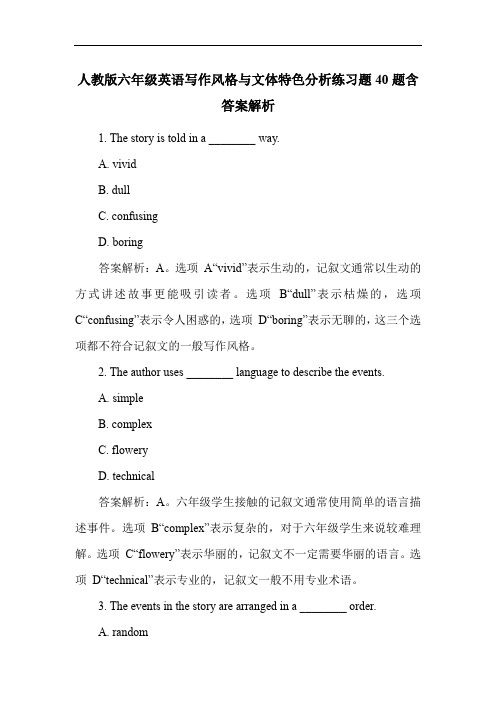
人教版六年级英语写作风格与文体特色分析练习题40题含答案解析1. The story is told in a ________ way.A. vividB. dullC. confusingD. boring答案解析:A。
选项A“vivid”表示生动的,记叙文通常以生动的方式讲述故事更能吸引读者。
选项B“dull”表示枯燥的,选项C“confusing”表示令人困惑的,选项D“boring”表示无聊的,这三个选项都不符合记叙文的一般写作风格。
2. The author uses ________ language to describe the events.A. simpleB. complexC. floweryD. technical答案解析:A。
六年级学生接触的记叙文通常使用简单的语言描述事件。
选项B“complex”表示复杂的,对于六年级学生来说较难理解。
选项C“flowery”表示华丽的,记叙文不一定需要华丽的语言。
选项D“technical”表示专业的,记叙文一般不用专业术语。
3. The events in the story are arranged in a ________ order.A. randomB. chronologicalC. reverseD. chaotic答案解析:B。
记叙文通常按照时间顺序(chronological order)来安排事件,这样更易于读者理解故事的发展。
选项A“random”表示随机的,选项C“reverse”表示倒序,选项D“chaotic”表示混乱的,都不符合记叙文常见的结构。
4. The main character in the story is described as ________.A. braveB. cowardlyC. meanD. lazy答案解析:A。
在很多记叙文中,主角通常具有积极的品质,勇敢((brave)是比较常见的一种。
文学类文本作业详解
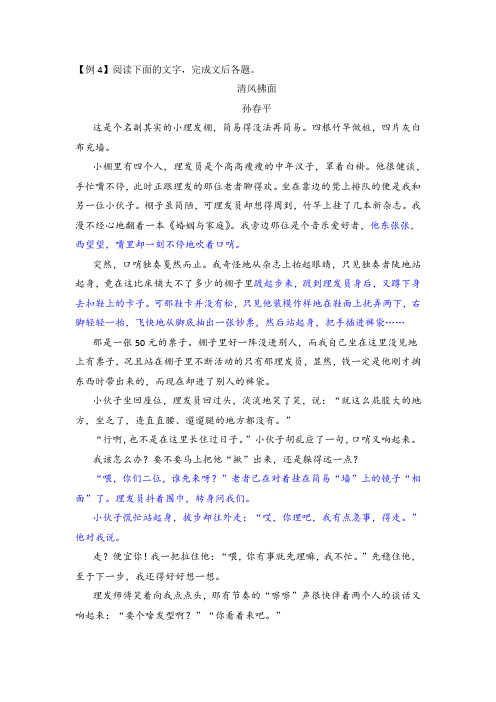
【例4】阅读下面的文字,完成文后各题。
清风拂面孙春平这是个名副其实的小理发棚,简易得没法再简易。
四根竹竿做桩,四片灰白布充墙。
小棚里有四个人,理发员是个高高瘦瘦的中年汉子,罩着白褂。
他很健谈,手忙嘴不停,此时正跟理发的那位老者聊得欢。
坐在靠边的凳上排队的便是我和另一位小伙子。
棚子虽简陋,可理发员却想得周到,竹竿上挂了几本新杂志。
我漫不经心地翻着一本《婚姻与家庭》。
我旁边那位是个音乐爱好者,他东张张,西望望,嘴里却一刻不停地吹着口哨。
突然,口哨独奏戛然而止。
我奇怪地从杂志上抬起眼睛,只见独奏者陡地站起身,竟在这比床铺大不了多少的棚子里踱起步来,踱到理发员身后,又蹲下身去扣鞋上的卡子。
可那鞋卡并没有松,只见他装模作样地在鞋面上抚弄两下,右脚轻轻一抬,飞快地从脚底抽出一张钞票,然后站起身,把手插进裤袋……那是一张50元的票子。
棚子里好一阵没进别人,而我自己坐在这里没见地上有票子,况且站在棚子里不断活动的只有那理发员,显然,钱一定是他刚才掏东西时带出来的,而现在却进了别人的裤袋。
小伙子坐回座位,理发员回过头,淡淡地笑了笑,说:“就这么屁股大的地方,坐乏了,连直直腰、遛遛腿的地方都没有。
”“行啊,也不是在这里长住过日子。
”小伙子胡乱应了一句,口哨又响起来。
我该怎么办?要不要马上把他“揪”出来,还是躲得远一点?“喂,你们二位,谁先来呀?”老者已在对着挂在简易“墙”上的镜子“相面”了。
理发员抖着围巾,转身问我们。
小伙子慌忙站起身,拔步却往外走:“哎,你理吧,我有点急事,得走。
”他对我说。
走?便宜你!我一把拉住他:“喂,你有事就先理嘛,我不忙。
”先稳住他,至于下一步,我还得好好想一想。
理发师傅笑着向我点点头,那有节奏的“嚓嚓”声很快伴着两个人的谈话又响起来:“要个啥发型啊?”“你看着来吧。
”理发师傅转身抓毛巾擦了擦脸上的汗:“小伙子,工作啦,还是念书呢?”“俺是临时工,正给热电厂撅屁股挖地沟呢。
”“甭愁,临时工也照样出息人。
文体学分析
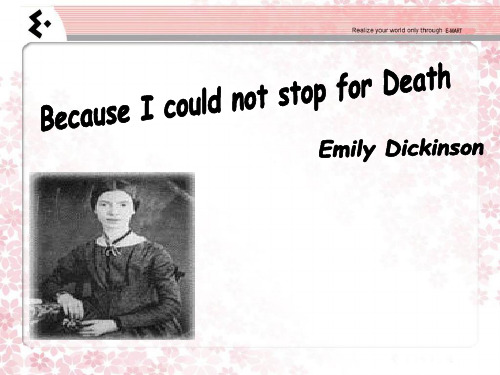
Emily Dickinson—
Introduction of the poet
• free and easy, showed us Emily`s meditation about death, exploration to life and desire for eternity.
TaBpwwetDacfbicoaeTthrHrmhooW twgrbDgdtcwsasaaDotGSsttsleheeirmaihheeaoferhieyeenaiihhhcyvrrefatifmkeaupticasimaaet.osnanrgarorkcmeeeeptlchehznptkvttwswcuimgdtniiaprkhifanrgdenria,aaeiecbinorSmfgiannhsnoiitoentreeelordetkggionwtnsioithyb,ghdhgesrrcasatpasnininwieehenoeshldnlhitnwotlhettsestitaceiwcta,.odndGedcfzpegdafyidniltoleiedeegcntsahwoee&ilpeeasreblhd.oshooyssthnhtenerdnlmisoaashorliitHeAltcfelteuuhsiethcteenss,eilreelfortsaraaisyennmshulahlnayeoicngstttawaaretgpnottcnt.strtetfdvaiunohchdaegdcuaxihseesarargtiiiShreersogmrdnte&esneitongepiieirre,“cemeeinbhnhenaohtrisdeeIreedpbdsqavnF..ltgttnrleefi1de,salmHcsalaehevutiDhgheioiSesrdspsrttneseytiiiemtsileiwapmfofsiieetnnniotiasluhidsgrdtal.s“ofysvvrhredegaa.iwccieoeDalsoSiW tnleteoessbjailatnnsNelhrdelewyfhaa.uemelieoshu.gtbypfdesineoosn’.aetnth’asaeascztftb,thtesght&lews,eaihiyestrnsin.”:rtyegoeh”df,
文体学考试大题分析
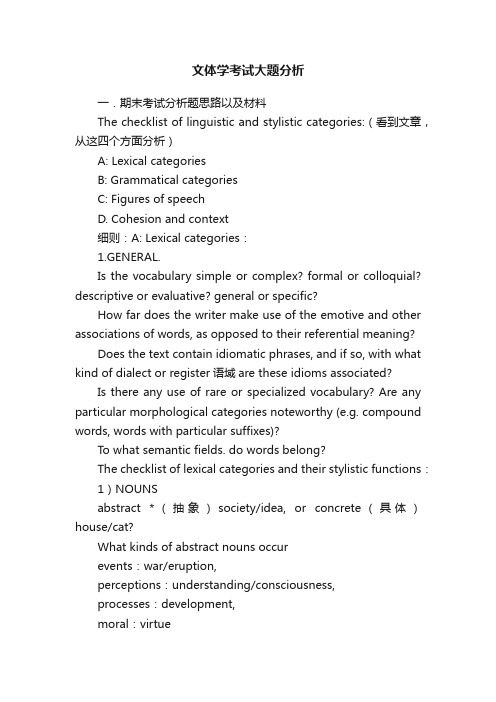
文体学考试大题分析一.期末考试分析题思路以及材料The checklist of linguistic and stylistic categories:(看到文章,从这四个方面分析)A: Lexical categoriesB: Grammatical categoriesC: Figures of speechD. Cohesion and context细则:A: Lexical categories:1.GENERAL.Is the vocabulary simple or complex? formal or colloquial? descriptive or evaluative? general or specific?How far does the writer make use of the emotive and other associations of words, as opposed to their referential meaning?Does the text contain idiomatic phrases, and if so, with what kind of dialect or register语域are these idioms associated?Is there any use of rare or specialized vocabulary? Are any particular morphological categories noteworthy (e.g. compound words, words with particular suffixes)?To what semantic fields. do words belong?The checklist of lexical categories and their stylistic functions:1)NOUNSabstract *(抽象)society/idea, or concrete(具体)house/cat?What kinds of abstract nouns occurevents:war/eruption,perceptions:understanding/consciousness,processes:development,moral:virtuesocial:responsibility,qualities:braveryWhat use is made of proper names? Are there any collective nouns people/staff?2)Adjectivereferring to what attribute?Physical:woolenpsychological :joyfulVisual:hilly square/snowyAuditory:bubbling/sizzlingsensory:slippery/smoothColor:dark/redreferential:big dog/white houseEmotive:exited/happyEvaluative:good/fat/ bad/lazyGradable:young/tall/usefulor non-gradable:atomic/British?Attributive:an utter foolor predicative he is ashore ?Restrictive the exact answer?Intensifying the simple truth /a complete victory/a slight effort?stative tall/longor dynamic abusive/ambitious?3)VerbsAre they stative cost/believe/remain, or dynamic walk/arrive?Do they refer to movements climb/jump/slide, physical acts spread/smell/taste/laugh, or speech acts persuade/decline/beg, psychological states or activities think/feel/imagine/know/love. or perceptions see/hear/feel?Are they transitive shut the door, intransitive the door shuts, or linking be/sound/seem/taste/ smell?Are they factive know/regret/forget/remember or non-factive believe/assume/consider/suppose/ think/ imagine?4)Adverbs5)What semantic functions do they perform?Manner anxiously/ carefully/ loudly/ willingly?place away/along/across/upstairs/elsewhere?direction backwards/forward/up/down/in/out?time ago/already/finally/shortly/immediately?degree almost/completely/partly/deeply/much?Are there any significant use of sentence adverbs?1) adjuncts like happily, proudly, now, outside?2) conjuncts like so, therefore, however?3) disjuncts like certainly, obviously, frankly?B: Grammatical categories1. SENTENCE TYPESDoes the author use only statements (declarative sentences), or does he also use questions, commands, exclamations. or minor sentence types (such as sentences with no verb)?If these other types are used, what is their function?2.SENTENCE COMPLEXITY.Do sentences on the whole have a simple or a complex structure?What is the average sentence length (in number of words)?What is the ratio of dependent to independent clauses?Does complexity vary strikingly from one sentence to another?Is complexity mainly due to (i) coordination, (ii) subordination, (iii) parataxis (juxtaposition of clauses or otherequivalent structures)?In what parts of a sentence does complexity tend to occur?For instance, is there any notable occurrence of anticipatory structure (e.g. of complex subjects preceding the verbs, of dependent clauses preceding the subject of a main clause)?3 CLAUSE TYPESWhat types of dependent clause are favored: relative clauses, adverbial clauses, different types of nominal clauses (that—clauses, wh—clauses, etc)?Are reduced or non-finite clauses commonly used, and if so, of what type are they (infinitive clauses, —ing clauses, —ed clauses, verbless clauses)?.4.CLAUSE STRUCTURE.Is there anything significant about clause elements (eg frequency of objects, complements, adverbials; of transitive or intransitive verb constructions)?Are there any unusual orderings (initial adverbials, fronting of object or complement, etc)? Do special kinds of clause construction occur? (Such as those with preparatory it or there)?5 NOUN PHRASESAre they relatively simple or complex?Where does the complexity lie (in pre-modification by adjectives, nouns, etc, or in post-modification by prepositional phrases, relative clauses, etc)?Note occurrence of listings (eg sequences of adjectives), coordination, or apposition.6. VERB PHRASES.Are there any significant departures from the use of the simple past tense?For example, notice occurrences and the functions of thepresent tense; of the progressive aspect (eg was lying); of the perfective aspect (eg has/had appeared);modal auxiliaries (eg can, must, would).7 OTHER PHRASE TYPES.Is there anything to be said about other phrase types: prepositional phrases, adverb phrases adjective phrases?8 WORD CLASSES.Having already considered major or lexical word classes, we may here consider minor word classes (‘function words’): prepositions, conjunctions, pronouns, determiners, auxiliaries, interjections.Are particular words of these types used for particular effect (eg the definite or indefinite article; first person pronouns I, we, etc; demonstratives such as this and that; negative words such as not, nothing, no) ?9 GENERAL.Note here whether any general types of grammatical construction are used to special effect e.g. comparative or superlative constructions; coordinative or listing constructions; parenthetical. constructions; appended or interpolated structures such as occur in casual speech.Do lists and co-ordinations (e.g. lists of nouns) tend to occur with two, three or more than three members?C: Figures of speechHere we consider the incidence of features which are fore-grounded by virtue of departing in some way from general norms of communication by means of the language code;for example, exploitation of regularities of formal patterning, or of deviations from thelinguistic code. For identifying such features, the traditionalfigures of speech (schemes and tropes) are often useful categories.1 GRAMMATICAL AND LEXICAL SCHEMES. (这一部分会和稍后说的第四部分略有重合)Are there any cases of formal and structural repetition (anaphora, parallelism, etc) or of mirror—image patterns (chiasmus)?Is the rhetorical effect of these one of antithesis, reinforcement, climax, anticlimax, etc.?2 PHONOLOGICAL SCHEMES.Are there any phonological patterns of rhyme, alliteration, assonance, etc?Are there any salient rhythmical patterns?Do vowel and consonant sounds pattern or cluster in particular ways?How do these phonological features interact with meaning?3 TROPES修辞.Are there any obvious violations of, or departures from the linguistic code?For example, are there any neologisms (such as Americanly)?deviant lexical collocations (such as portentous怪异的infants)?semantic, syntactic, phonological, or graphological deviations?Such deviations will often be the clue to special interpretations associated with traditional figures of speech such as metaphor, metonymy, synecdoche, paradox, irony.If such tropes occur, what kind of special interpretation is involved (eg metaphor can be classified as personifying, animizing, concretizing, synaesthetic, etc)?D: Context and cohesionUnder COHESION衔接ways in which one part of a text is linked to another are considered: for example, the ways in which sentences are connected.This is the internal organization of the text.Under CONTEXT we consider the external relations of a text or a part of a text, seeing it as a discourse presupposing a social relation between its participants (author and reader; character and character, etc), and a sharing by participants of knowledge and assumptions.I.COHESION.Does the text contain logical or other links between sentences (eg coordinating conjunctions, or linking adverbials)?Or does it tend to rely on implicit connections of meaning?What sort of use is made of cross—reference by pronouns (she, it, they, etc)? by substitute forms (do, so, etc), or ellipsis?Alternatively, is any use made of elegant variation —the avoidance of repetition by the substitution of a descriptive phrase(as, for example, ‘the old lawyer’or ‘her uncle’may substitute for the rep-etition o f an earlier ‘Mr. Jones’)?Are meaning connections reinforced by repetition of words and phrases or by repeatedly using words from the same semantic field?2.CONTEXT.Does the writer address the reader directly, or through the words or thoughts of some fictional character?What linguistic clues (first-person pronouns I, me, my, mine) are there of theaddresser-addressee relationship?What attitude does the author imply towards his subject?If a character’s words or thoughts are represented, is this done by direct quotation: direct speech), or by some other method (eg indirect speech. free indirect speech)?Are there significant changes of style according to who is supposedly speaking or thinking the words on the page?以下这篇是老师给的一个例子:(咱们可以当作模版来用,但如果题目不一样,照上面)题目:From Joseph Conrad, The Secret SharerOn my right hand there were lines of fishing stakes resembling a mysterious system of half-submerged bamboo fences, incomprehensible in its division of the domain of tropical fishes, and crazy of aspect as if abandoned for ever by some nomad tribe of fishermen now gone to the other end of the ocean; for there was no sign of human habitation as far as the eye could reach(1). To the left a group of barren islets, suggesting ruins of stone walls, towers, and blockhouses, had its foundations set in a blue sea that itself looked solid, so still and stable did it lie below my feet; even the track of light from the westering, sun shone smoothly, without that animated glitter which tells of an imper-ceptible ripple(2). And when I turned my head to take a parting glance at the tug which had just left us anchored outside the bar, I saw the straight line of the flat shore joined to the stable sea, edge to edge, with a perfect and unmarked closeness, in one leveled floor half brown, half blue under the enormous dome of the sky(3). Corresponding in their insignificance to the islets of the sea, two small clumps of trees, one on each side of the only fault in the impeccable joint, marked the mouth of the river Meinam we had just left on the first preparatory stage of our homeward journey; and, far back on the inland level, a larger andloftier mass, the grove surrounding the great Paknam pagoda, was the only thing on which the eye could rest from the vain task of exploring the monotonous sweep of the horizon(4). Here and there gleams as of a few scattered pieces of silver marked the windings of the great river; and on the nearest of them, just within the bar, the tug steaming right into the land became lost to my sight, hull and funnel and masts, as though the impassive earth had swallowed her up without an effort, without a tremor(5). My eye followed the light cloud of her smoke, now here, now there, above the plain, according to the devious curves of the stream, but always fainter and farther away, till I lost it at last behind the miter-shaped hill of the great pagodas(6). And then I was left alone. with my ship, anchored at the head of the Gulf of Siam.Analysis:1.Lexical featuresnouns1)almost half the concrete nouns refer to things which divide the field of vision into geographical areas: domain, ocean, islets, sea, shore, sky, river, earth and so on.2)abstract lovative nouns, indicating geometrical features: lines, division, end, track, head, line, edge, joint and so on.All these nouns refer to objects of vision.General:an account of the relation between the visual world and its observer, who tries to comprehend and interpret it.the word "eye" is used repetedly in abstract nouns implying perception (aspect, sign, glitter, ripple, glance)and verbs like see, mark and lookTherefore, the passage is not only with objects of perception, but with the process of perceiving them.The writer avoids using verbs with a human agent, the "eye"instead as if had a will of its own. This evokes the feeling that the narrator is detached and powerless in the face of this immensity.The adjectives express strangeness or lack of definition, like half-submerged, mysterious, incomprehensible, unmarked.These all suggest a congruity between the eye which things are "imperceptible" and the mind to which things are "incomprehensible".2.Grammatical featuresSentence length:in words: 66-59-61-88-61-44-18Only after we have felt the isolation of the speaker in all its details and have seen the last vestige of human life disappear over the horizon, that we can understand the force of the simple statement.Sentence structure imitates the movement from the observer's eye towards the distance. Sentences tend to end in a evocation of vastness and remoteness, as the eye reaches its limit of vision.Prepositions:Unusually large number of prepositions (9), particularly those of place and direction.The role of "of" is to relate two noun expressions together, and the former always an abstract noun and collecve noun,"a group of barren islets","two small clumps of trees".This suggests that perception and cognition go hand in hand.3.Figures of speech:Simile,metaphor4.cohesion and context:No conspicuous use of logical and referential links.Most sentences begin with a reference to the first-person narrator. In the final sentence attention is abruptly brought back from the remote horizon to the observer himself.二.其它题使用材料(1)修辞手法有以下10种:1. Simile 明喻1). as…..asas white as a sheet /snow; as bold/brave as a lionas cool as a cucumber; as free as a birdas hungry as a hunter/hawk/bear/wolfas happy as a princeJim looks like his brother Bill. (not simile)Jim and Bill are as alike as two peas in a pod. (simile)As innocent as a baby; as light as a featherAs poor as a church mouse; as stubborn as a muleAs quick as a lightning/a flashHurry up! You walk as slow a snail.2). Like/asMy heart is like a singing birdwhose nest is in a watered shoot.我的心像只鸣啼的小鸟在柔润的技条上筑着巢Wit without learning is like a tree without fruit.有天资而无学识,好比树木不结果实。
学年高中语文每日一题分析文本的文体特征和主要表现手法含解析新人教版必修22019030415

分析文本的文体特征和主要表现手法阅读下面的文字, 完成问题。
半个世纪前的一天, 法国巴黎市民从当天报纸上看到一个十分醒目的消息:昨天, 法国物理学家夏里·法布里教授, 作为新当选的法国科学院院士, 出席了科学院院士例会。
按照老规矩, 院士第一次参加例会, 要宣读一篇高水平的论文。
不过, 出乎大家意料的是, 夏里·法布里教授没有宣读自己的论文, 而是宣读了在他指导下的一位中国年轻的物理学家的论文。
教授自豪地告诉与会者, 这位年轻的中国物理学家由于出色的研究成果, 将获得法国国家科学博士学位, 成为第一位荣获这一荣誉的中国人。
巴黎的报纸还刊登了夏里教授和这位中国年轻科学家的大幅照片。
这一消息使巴黎人惊奇异常, 因为在他们眼里, 中国是一个贫穷、落后又愚昧的国家, 而今天, 竟然有一位年轻的中国人登上了法国神圣的科学殿堂。
要知道, 即使是法国科学家, 要获得法国国家级科学博士学位, 也是不容易的。
这位令巴黎人大吃一惊的中国人, 就是我国著名的物理学家严济慈。
严济慈出生在浙江东阳县的一个小村庄, 他是农民的儿子。
7岁时, 进入严家祠堂的蒙馆读书, 读四书五经, 但他对那些艰涩的圣贤之言没有兴趣。
有一次, 他父亲到杭州去办事, 无意中在一个书摊上发现一本《笔算数学》, 便买回来给了严济慈, 严济慈高兴极了。
当时, 村子里谁都没有学过高深的数学, 也找不到可以请教的老师。
严济慈硬着头皮自己“啃”, 硬是“啃”下了这本书。
14岁时, 严济兹考上了浙江东阳县立中学, 成绩是所有考生中最优秀的。
家里省吃俭用, 把这个“严家几辈子才出的读书人”送进了中学的大门。
严济慈没有辜负父母的期望, 他刻苦用功, 每学期的成绩都在班上名列前茅, 以优异的成绩完成了中学学业。
这年夏天, 他来到省城杭州报考大学。
考虑到家里经济困难, 他决定报考离家最近的南京高等师范, 因为师范不仅免交学费, 还免费提供食宿。
高考实用文体阅读之分析题分析及真题回顾(解析版)
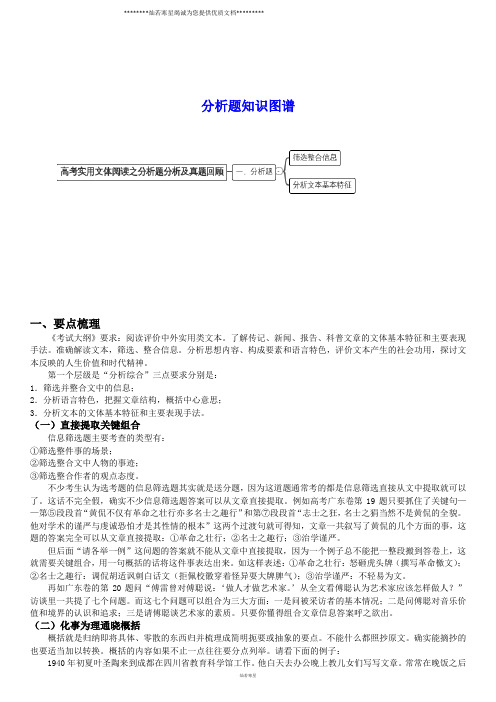
分析题知识图谱一、要点梳理《考试大纲》要求:阅读评价中外实用类文本。
了解传记、新闻、报告、科普文章的文体基本特征和主要表现手法。
准确解读文本,筛选、整合信息。
分析思想内容、构成要素和语言特色,评价文本产生的社会功用,探讨文本反映的人生价值和时代精神。
第一个层级是“分析综合”三点要求分别是:1.筛选并整合文中的信息;2.分析语言特色,把握文章结构,概括中心意思;3.分析文本的文体基本特征和主要表现手法。
(一)直接提取关键组合信息筛选题主要考查的类型有:①筛选整件事的场景;②筛选整合文中人物的事迹;③筛选整合作者的观点态度。
不少考生认为选考题的信息筛选题其实就是送分题,因为这道题通常考的都是信息筛选直接从文中提取就可以了。
这话不完全假,确实不少信息筛选题答案可以从文章直接提取。
例如高考广东卷第19题只要抓住了关键句——第⑤段段首“黄侃不仅有革命之壮行亦多名士之趣行”和第⑦段段首“志士之狂,名士之狷当然不是黄侃的全貌。
他对学术的谨严与虔诚恐怕才是其性情的根本”这两个过渡句就可得知,文章一共叙写了黄侃的几个方面的事,这题的答案完全可以从文章直接提取:①革命之壮行;②名士之趣行;③治学谨严。
但后面“请各举一例”这问题的答案就不能从文章中直接提取,因为一个例子总不能把一整段搬到答卷上,这就需要关键组合,用一句概括的话将这件事表达出来。
如这样表述:①革命之壮行:怒砸虎头牌(撰写革命檄文);②名士之趣行:调侃胡适讽刺白话文(拒佩校徽穿着怪异耍大牌脾气);③治学谨严:不轻易为文。
再如广东卷的第20题问“傅雷曾对傅聪说:‘做人才做艺术家。
’从全文看傅聪认为艺术家应该怎样做人?”访谈里一共提了七个问题。
而这七个问题可以组合为三大方面:一是问被采访者的基本情况;二是问傅聪对音乐价值和境界的认识和追求;三是请傅聪谈艺术家的素质。
只要你懂得组合文章信息答案呼之欲出。
(二)化事为理通晓概括概括就是归纳即将具体、零散的东西归并梳理成简明扼要或抽象的要点。
高一语文每日一题(第7周)分析文本的文体特征和主要表现手法(含解析)(2021学年)
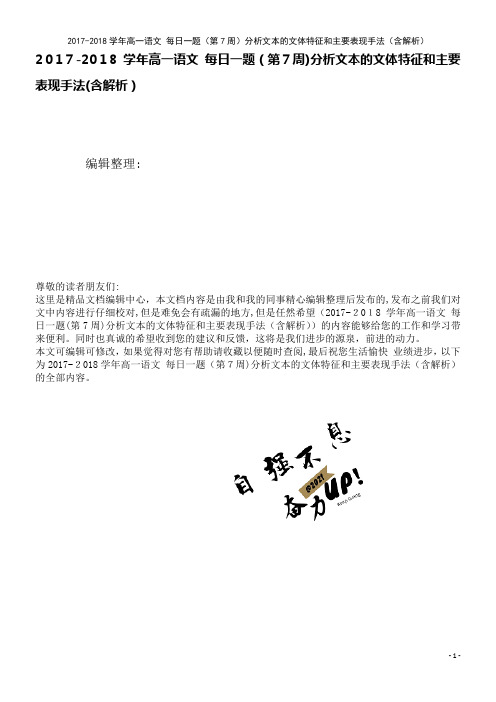
2017-2018学年高一语文每日一题(第7周)分析文本的文体特征和主要表现手法(含解析)编辑整理:尊敬的读者朋友们:这里是精品文档编辑中心,本文档内容是由我和我的同事精心编辑整理后发布的,发布之前我们对文中内容进行仔细校对,但是难免会有疏漏的地方,但是任然希望(2017-2018学年高一语文每日一题(第7周)分析文本的文体特征和主要表现手法(含解析))的内容能够给您的工作和学习带来便利。
同时也真诚的希望收到您的建议和反馈,这将是我们进步的源泉,前进的动力。
本文可编辑可修改,如果觉得对您有帮助请收藏以便随时查阅,最后祝您生活愉快业绩进步,以下为2017-2018学年高一语文每日一题(第7周)分析文本的文体特征和主要表现手法(含解析)的全部内容。
分析文本的文体特征和主要表现手法阅读下面的文字,然后回答问题.银川110多小时“全城总动员”为4岁女童找到丢失的“耳朵”何晨阳2013年11月,“为4岁女孩找‘耳朵'”的帖子和海报遍布宁夏银川市的贴吧、论坛和大街小巷,在网民、群众、媒体、政府部门官微110多小时的齐力寻找下,终于将4岁女童的“耳朵”找到,这场爱心接力,不仅为一个外来务工者家庭避免了20多万元的损失,更让小女孩免受再次开颅手术之苦。
孩子的“耳朵"怎么会丢呢?宋国强和妻子是身在银川的外来务工者,他们的女儿小儒(化名)出生后不久,他们发现小家伙对有声世界毫无反应,去医院检查后发现孩子患有极重度感音神经性耳聋.一晃四年过去了,同龄的孩子早已牙牙学语,小儒却一直生活在无声世界里。
2013年1月,宋国强听说人造耳蜗能帮孩子回到“有声世界”,便借钱凑了28万多元购买并为孩子植入了进口的人造耳蜗。
半年多,小儒已经学会了简单的日常用语,耳蜗成了她的“耳朵".2013年11月10日晚上9点左右,宋国强的妻子和孩子在新华东街等车时将耳蜗体外处理器丢失.这种耳蜗由体内植入体和体外处理器两部分组成,且是一对一配对,如果一部分丢失,另外一部分也将失效。
高考语文现代文阅读专练(14)分析文体特征和表现手法(含答案)
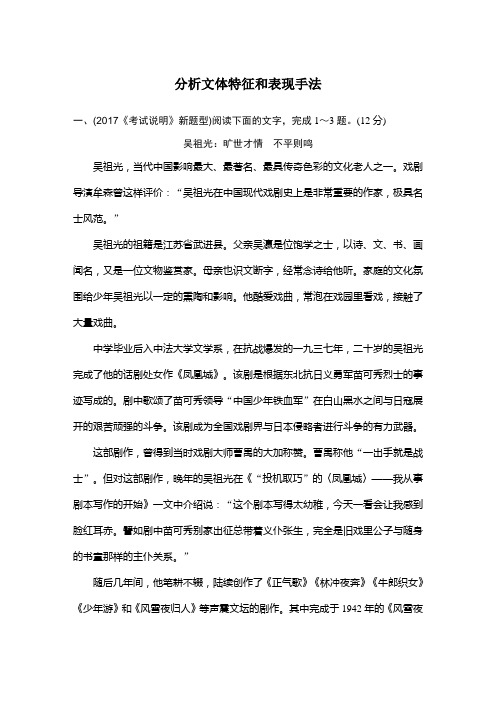
分析文体特征和表现手法一、(2017《考试说明》新题型)阅读下面的文字,完成1~3题。
(12分)吴祖光:旷世才情不平则鸣吴祖光,当代中国影响最大、最著名、最具传奇色彩的文化老人之一。
戏剧导演牟森曾这样评价:“吴祖光在中国现代戏剧史上是非常重要的作家,极具名士风范。
”吴祖光的祖籍是江苏省武进县。
父亲吴瀛是位饱学之士,以诗、文、书、画闻名,又是一位文物鉴赏家。
母亲也识文断字,经常念诗给他听。
家庭的文化氛围给少年吴祖光以一定的熏陶和影响。
他酷爱戏曲,常泡在戏园里看戏,接触了大量戏曲。
中学毕业后入中法大学文学系,在抗战爆发的一九三七年,二十岁的吴祖光完成了他的话剧处女作《凤凰城》。
该剧是根据东北抗日义勇军苗可秀烈士的事迹写成的。
剧中歌颂了苗可秀领导“中国少年铁血军”在白山黑水之间与日寇展开的艰苦顽强的斗争。
该剧成为全国戏剧界与日本侵略者进行斗争的有力武器。
这部剧作,曾得到当时戏剧大师曹禺的大加称赞。
曹禺称他“一出手就是战士”。
但对这部剧作,晚年的吴祖光在《“投机取巧”的〈凤凰城〉——我从事剧本写作的开始》一文中介绍说:“这个剧本写得太幼稚,今天一看会让我感到脸红耳赤。
譬如剧中苗可秀别家出征总带着义仆张生,完全是旧戏里公子与随身的书童那样的主仆关系。
”随后几年间,他笔耕不辍,陆续创作了《正气歌》《林冲夜奔》《牛郎织女》《少年游》和《风雪夜归人》等声震文坛的剧作。
其中完成于1942年的《风雪夜归人》是吴祖光的代表作。
这部剧作集中体现了吴祖光以戏曲思维创作话剧的另一种思路,他将中西戏剧“写实”与“写意”艺术手法相融合,尝试不同题材和富有异趣的创作风格,对民族戏剧的现代化和现代话剧的民族化做出了有益的探索。
除了艺术上久负盛名,吴祖光还被称为中国知识分子的脊梁。
作为剧作家,吴祖光连续撰文抨击国民党统治之下的审查制度,称之为“奴隶的审查制度”。
他抨击国民党删除曹禺之作《蜕变》中“打游击”的情节;他嘲讽蒋介石因自己是秃头而将张天翼的童话《秃秃大王》改成《猴儿大王》;他愤怒自己创作的《正气歌》被国民党删去关于朝廷昏庸的所有内容。
2023届高考语文二轮复习教案:论述类文本阅读—文体知识 例题分析(含答案)
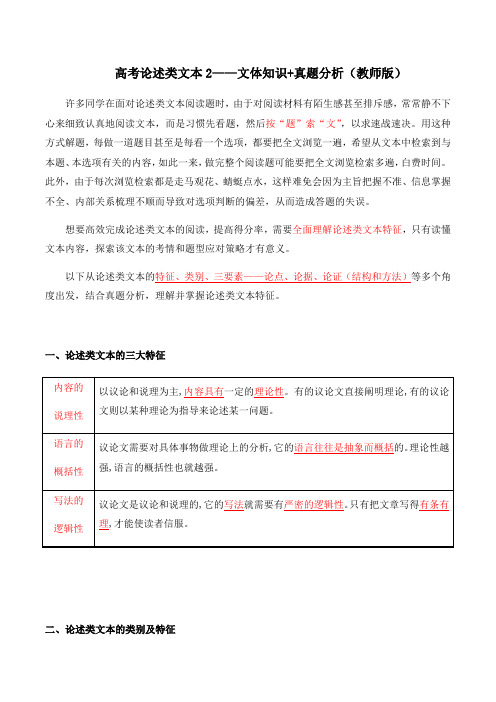
高考论述类文本2——文体知识+真题分析(教师版)许多同学在面对论述类文本阅读题时,由于对阅读材料有陌生感甚至排斥感,常常静不下心来细致认真地阅读文本,而是习惯先看题,然后按“题”索“文”,以求速战速决。
用这种方式解题,每做一道题目甚至是每看一个选项,都要把全文浏览一遍,希望从文本中检索到与本题、本选项有关的内容,如此一来,做完整个阅读题可能要把全文浏览检索多遍,白费时间。
此外,由于每次浏览检索都是走马观花、蜻蜓点水,这样难免会因为主旨把握不准、信息掌握不全、内部关系梳理不顺而导致对选项判断的偏差,从而造成答题的失误。
想要高效完成论述类文本的阅读,提高得分率,需要全面理解论述类文本特征,只有读懂文本内容,探索该文本的考情和题型应对策略才有意义。
以下从论述类文本的特征、类别、三要素——论点、论据、论证(结构和方法)等多个角度出发,结合真题分析,理解并掌握论述类文本特征。
一、论述类文本的三大特征二、论述类文本的类别及特征(一)政论文(二)学术论文(三)文艺评论(四)时评(五)书评三、论述类文本的三要素:论点、论据、论证(一)文章的灵魂统帅——论点(需要证明什么)1. 论点往往是正确、鲜明阐述作者观点的句子,是一篇文章的灵魂、统率。
一篇文章只能有一个中心论点,中心论点之下可以有若干分论点。
中心论点与分论点之间是统率与被统率的关系,而各分论点之间不能相互矛盾、交叉或包含。
2. 论点在文本中的位置:(二)文章的血肉支撑——论据(用什么来证明):是支撑论点的材料,是作者用来证明论点的理由和根据,分为事实论据和理论论据两种。
【注】立论和驳论:(三)文章的骨骼建构——论证(怎样来证明):是用严密论据来证明论点的过程。
论证的目的在于揭示出论点和论据之间的内在逻辑关系。
1. 论述类文本的四大论证结构【注】论证结构是指议论文的行文思路和基本结构,一般由“引论”“本论”“结论”三部分组成,遵循“提出问题(引论)→分析问题(本论)→解决问题(结论)”的“三段论”模式。
专项模块2 分析文体特征题

第2轮 语文(全国版)
返回导航
知识回扣 题点突破
栏目索引
专项模块2 分析文体特征题
知识回扣
第2轮 语文(全国版)
返回导航
专项模块2 分析文体特征题
题点突破
1.新闻的解题技巧 (1)解读新闻内容——明“新闻要点” 新闻和其他叙事性文体一样,须具备六个要素:时间、地点、人物、起因、经过、 结果。对于多则材料新闻,要抓住其共同话题,可提炼文本中出现频率高的词语,以 把握新闻核心内容。
第2轮 语文(全国版)
返回导航
专项模块2 分析文体特征题
《南风窗》:逻辑思维必须讲究概念的明晰。而古代的一些经典,好像喜欢玩模 糊、神秘。是否可以这样理解:中国古人对关于世界本质的知识论追求没有兴趣?
赵汀阳:古代中国思想注意力主要集中在人类生活问题上,伦理、政治、战争、 和平之类。不过西方思想也同样关心这些问题。西方思想寻找永恒的、完美的终极概 念;追求永恒的“完美概念”——绝对无私的牺牲、绝对纯洁的母亲,千年不坏的城 堡……
第2轮 语文(全国版)
返回导航
专项模块2 分析文体特征题
2.访谈的解题技巧 (1)通读文本,把握话题。即了解访问者和访谈对象所讨论的中心问题是什么。 (2)拆分问答,体会技巧。将访问者和访谈对象的文字分开,先读提问者(访问者) 的问题,把握有哪些主要问题,问题之间有什么联系,有无铺垫;再阅读访谈对象的 文字,大致把握其阐述的内容,分析其回答的技巧——是正面回答,还是委婉暗示。 (3)结合主旨,分析作用。访问者的提问有一定的技巧,如直问、追问、推问等; 访谈对象的回答也有其特点和目的。这都要结合文章的主旨和人物的特点分析。
专项模块2 分析文体特征题
4.科普文的解题技巧 (1)快速浏览文本,捕捉文章话题。科普文有明确的写作对象,是哪一领域的科技 知识,有关什么问题的报告,这是首先必须弄清的。在此基础上,进一步体会文章写 了什么内容,运用了什么方法,具有怎样的特点。 (2)注意语言特色,关注文体特征。科普文有语言准确的要求,因此要特别留意那 些起限定作用的词语和表示各种判断的副词,注意语言的严谨、准确;同时科普文有 语言生动、形象的要求,因此还要留意科普文的文学性、形象性等特点。
初二英语写作文体分析单选题40题
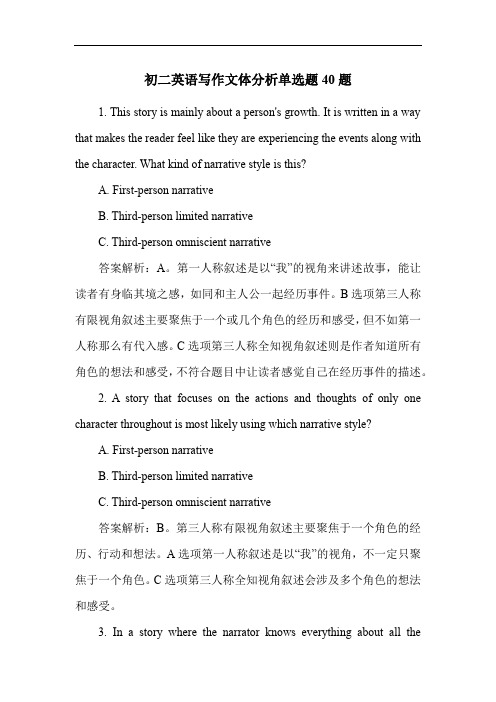
初二英语写作文体分析单选题40题1. This story is mainly about a person's growth. It is written in a way that makes the reader feel like they are experiencing the events along with the character. What kind of narrative style is this?A. First-person narrativeB. Third-person limited narrativeC. Third-person omniscient narrative答案解析:A。
第一人称叙述是以“我”的视角来讲述故事,能让读者有身临其境之感,如同和主人公一起经历事件。
B选项第三人称有限视角叙述主要聚焦于一个或几个角色的经历和感受,但不如第一人称那么有代入感。
C选项第三人称全知视角叙述则是作者知道所有角色的想法和感受,不符合题目中让读者感觉自己在经历事件的描述。
2. A story that focuses on the actions and thoughts of only one character throughout is most likely using which narrative style?A. First-person narrativeB. Third-person limited narrativeC. Third-person omniscient narrative答案解析:B。
第三人称有限视角叙述主要聚焦于一个角色的经历、行动和想法。
A选项第一人称叙述是以“我”的视角,不一定只聚焦于一个角色。
C选项第三人称全知视角叙述会涉及多个角色的想法和感受。
3. In a story where the narrator knows everything about all thecharacters and can describe their inner thoughts and feelings, what narrative style is being used?A. First-person narrativeB. Third-person limited narrativeC. Third-person omniscient narrative答案解析:C。
- 1、下载文档前请自行甄别文档内容的完整性,平台不提供额外的编辑、内容补充、找答案等附加服务。
- 2、"仅部分预览"的文档,不可在线预览部分如存在完整性等问题,可反馈申请退款(可完整预览的文档不适用该条件!)。
- 3、如文档侵犯您的权益,请联系客服反馈,我们会尽快为您处理(人工客服工作时间:9:00-18:30)。
葛底斯堡演说的文体学分析[摘要]:1863 年11 月19 日在葛底斯堡举行烈士公墓落成典礼仪式上,林肯作了演讲,对这次战争中先烈之灵表达了深切悼念,号召人民为了国家的存亡和自由平等前仆后继。
演讲辞结构严谨,句式错落有致,措辞精练,语言真挚,感人肺腑。
本文从文体学的句法角度来分析其文学特点。
葛底斯堡战役是美国历史上流血最多的一次战役,也是美国南北战争中的一个具有决定意义的转折点。
为纪念这次战役,北方各州决定在葛底斯堡修建烈士公墓并举行一个仪式。
仪式的主要演讲人是哈佛大学校长,当时最有名的演说家埃弗里特,林肯也应邀出席并作了葛底斯堡演讲。
埃弗里特用了几个月的时间准备他的演讲稿,在仪式上滔滔不绝地讲了两个小时,而林肯上去只讲了两分钟。
埃弗里特两个小时的演讲很快就没有人记得了,然而林肯的这次演讲却成为永世传诵的名篇,这就是历史上著名的葛底斯堡演说。
他的这篇演讲辞的影响深刻、博大而富有意义,被誉为美国历史上最优秀的演讲辞之一。
他的演讲旨在表明一个新生国家、新生政权的性质和宗旨,从而鼓舞联邦士兵为捍卫祖国的统一浴血奋战,赢得战争的胜利,可以算得上是一篇经典之作。
本文从文体学角度来分析这篇阐述民主信念的最雄辩动人的演讲辞。
林肯的演说不仅表现了其独特的个人魅力,而且在词语选用、语言节奏、句法、修辞方面也别具匠心。
一篇优秀的演讲词往往文辞优美,主旨鲜明,富有力量和感染力,能时刻抓住听众的注意力。
本文着重从句法层面来分析这篇演讲词的特点。
当句法层面上出现前景化时,可利用词类(如名词、动词、形容词等)知识分析非常规的或标记性的词序或句法组合。
由于公众演讲的空间限制和形式决定它较之日常谈话更正式和严明的特点,又由于公众演讲对象水平多层次限制和演讲引起听众共鸣的目的和要求,它没有法律问题或科技问题那么正式,演讲的文体介于口语和书面语之间,因此公众演讲在句法结构方面也有了更多的鲜明特色。
①句子结构。
演讲问题的句子长度比日常谈话、即席演说或商业广告等文体都有明显的增加。
在整篇演讲中共有271个词, 10句话,平均每句话有27. 1个词,在最短的句子有10个词,而在最长的句子则由82词构成,远远超过了英语中每句17. 6个词的词量,很好地描绘了未来的方向,以独特的令人易接受的方式激励人们不懈地奋斗。
从对演讲的统计可以看出,含词量大部分集中在每句20—30词之间,而不存在含词量在10个以下的句子,这与日常生活对话的含词量大多在10个以下的形成鲜明的对照。
随着句子长度的增加,句子结构也自然的更复杂了,在构成整篇演讲词的10句话中,复合句占了9句(除第3句) ,比率高达90%之多,句子结构如此复杂是在日常谈话等交流中不常见的。
此外,在短短的10句话中出现了4个动词不定式和4个动名词,这也无疑增加了句子的复杂性。
在句子成分的组织上可以观察到,以主语开头的句子是7句,这样可以使读者经济便捷地抓住有效信息,同时3个以状语开头的句子的比重较日常用语有较大的增加,这样给读者设下悬念,能够引起读者兴趣,并使整个演讲富有变化、跌宕起伏,符合其文体特征和演讲目的。
②句子类型。
演讲与日常的双向交流不同。
它要求演讲者事前要进行准备使其易于理解,并具有煽动性,避免表达和理解的重复性。
因此,在演讲在动词词组的运用除有简单化的特点外,在句子类型上力求趋于完整准确,并庄重可信。
其中在本篇演讲中的10句话无一例外地使用了陈述句,适应了这一要求,演讲者并没有使用疑问句是为避免演讲内容可信度的降低。
既然是演说词又无一例外的要求语言的文采。
在此篇中林肯的语言文采就表现在他经常使用的对偶和排比的修辞手法。
使用这种修辞手法可以使语句整齐匀称,显示形式的整体美。
这也是此篇演讲声调铿锵有力,语义丰富集中,说理有力的原因。
其中的第二段是最好的例子,也是本篇的中心,共有167个词,分为5个句子,占了全文篇幅的三分之二。
为了使语言简练,声调铿锵,说理有力,作者采用了对偶的修辞手法把三个简单句并列在一起,不用连词,仅用逗号把它们隔开;三个并列的简单句都重复we can not,为的是强调听众的印象。
But, in a larger sense, we cannot dedicate, we cannot consecrate, we cannot hallow this ground.接下去的一个并列句也是对偶句。
两个并列句使用一对反义词( note, remember/ forget)做谓语动词并各带一个以what引导的宾语从句:The world will little note nor long remember what we say here, but it can never forget what they did here.跟着的是两个以it为形式主语,以不定式短语为真正主语的句子构成的平行结构,把对偶和层进( climax)相糅合。
这两个对偶句在意义上又是递进的阐述,进一步深入,很有气势:It is for us, the living, rather to be dedicated here to the unfinished work which they who foughthere have this far so nobly advanced. It is rather for us to be dedicated here to the great task remaining before us.接下去是连续使用that,实际上是so that引导的目的状语从句。
这又是一个对偶:That form these honored dead, we take increased devotion to that cause for which they gave the last full measure of devotion; that we here highly resolve that dead shall not have died in vain.最后又用了三个that引导的从句,但是引导的不是状语从句而是三个宾语从句。
这也是对偶的修辞手法:That these dead shall not have died in vain; that this Nation, under God, shall have a new birth of freedom; and that government of the people by the people and for the people shall not perish form the earth.第三个宾语从句中的of the people by the people and for the people也使用了排比的修辞手法。
③短语组合模式。
在句法层面上,除了分析句子结构外,还可以寻找不同类型的短语(如名词短语、动词短语等)组合模式,这种模式往往使语言更趋于文学化。
为了便于不同层次的观众获得信息,演讲词的动词词组不是很复杂,演讲中共有33个动词词组,其中只含一个成分,即主动词的有15个,占到接近半数的比重,其它大多是含有两个成分的词组,以完成时和情态动词为主。
含有三个成分的词组仅有一个,并且是完成时的被动形式。
这些动词词组的时态情况比比较来说复杂一些,其中现在时仍占主体地位,有12个,占41. 3%;过去时有8个,占27. 6%;将来时有6个,占17. 2%;完成时有4个,占13. 9%。
这主要是由演讲的内容决定的。
在揭幕礼上缅怀过去、憧憬未来的内容也相应决定了各种时态应用的频率和侧重点。
林肯的演讲中侧重对将来的期望,希望人们可以团结一致,为国家的统一做出贡献。
在名词词组方面,演讲文体的名词词组明显地比其他文体的名词词组复杂,虽然它的前置修饰成分没有广告文体那么复杂,但是后置修饰成分则大大超过了这些文体,演讲文体句子结构的复杂大部分是由复杂的名词后置修饰成分引起的。
如:We have come to dedicate a portion of that field, as a final resting place for those who here gave their lives to that nation might live.And that government of the people, by the people, and for the people, shall not perish from the earth.It is for us the living, rather, to be dedicated here to the unfinished work which they who fought here have thus far so nobly advanced.名词修饰的增多能够使名词的限定更加精确,并能提供更多的信息,但另一方面也增加了理解的难度。
④句子时态的选择。
韩礼德把语言的元功能分为概念功能、人际功能和语篇功能。
概念功能包括经验功能(experientialfunction)和逻辑功能(logical function)两部分。
逻辑功能指的是语言对两个或两个以上的意义之间逻辑关系的表达。
经验功能是指语言对人们在现实世界(包括内心世界)中的各种经历的表达。
换言之,就是反映客观世界和主观世界中所发生的事、所牵涉的人和物以及与之有关的时间、地点等环境因素。
语言对人们在现实世界的经验功能主要是通过“及物性”(transitivity)和“语态”(voice)得以体现的。
韩礼德对及物系统的六个过程中的每种过程所适合的语态及其功能都进行了分析,但是他对概念功能和语篇功能分析的比较详细,而对人际功能的分析比较简单。
在功能语法的理论框架中,人际元功能指在话语情境中说话人和话语接受者之间的互动关系,以及说话人对其所说或所写的内容的态度。
如韩礼德指出,它带有很重的语义负荷。
它的词汇语法资源有:语气、情态、语调强调及其它评价手段,它们在语篇中韵律性的实现语言的人际功能。
根据功能语言的观点,人际意义不但可以体现在语法中的语气系统和情态系统,而且还可以借助于称呼语、人称代词以及可以表达讲话者态度的动词、名词、形容词和副词等具体词汇来体现。
而被动语态相对主动语态来说, 主要的变化就体现在动词的变化上,因此人际意义在被动语态的使用中一定会体现出来。
人际意义功能近些年来越来越多的受到学者们的关注,它涉及讲话者的身份、地位、态度、动机以及讲话者对事物的推断、参加社会活动、建立社会关系等。
讲话者可以通过这一手段使自己参与到某一情景语境中,通过词、句、语法、语篇直接或者间接地表达他的态度并影响他人的态度和行为,表现出一定的人际意义来。
